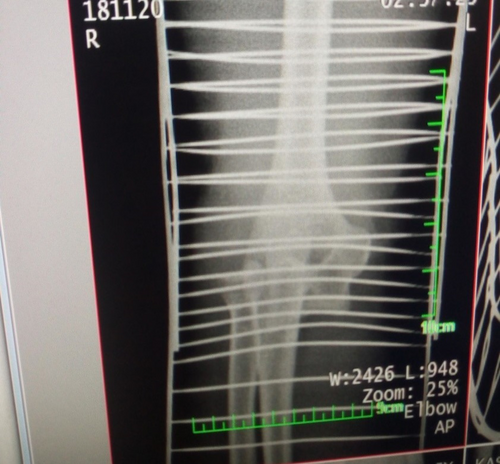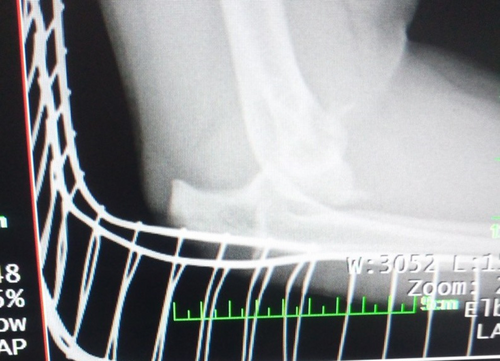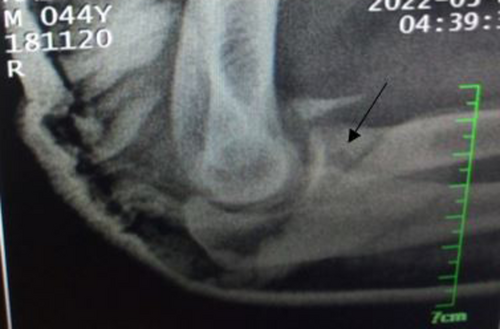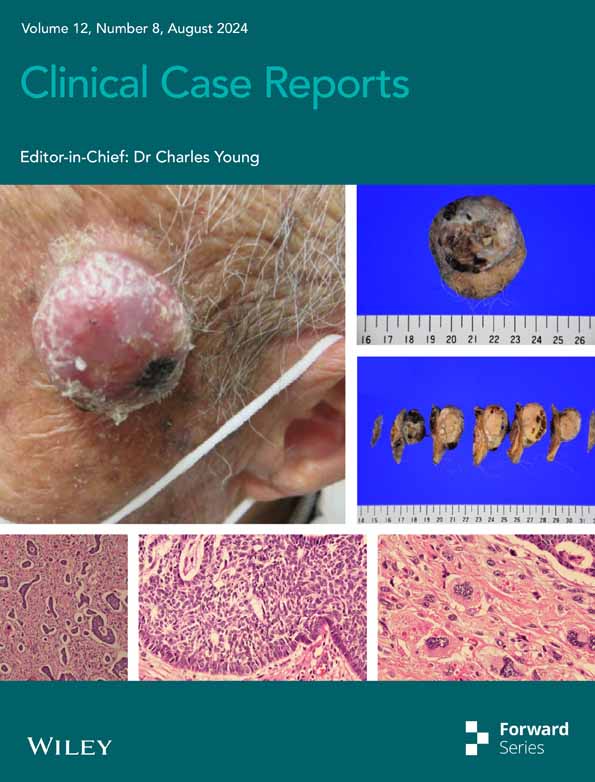Unusual posterior elbow dislocation associated with radial head fracture managed nonoperatively in low- and middle-income countries: A case report and literature review
Abstract
Key Clinical Message
In LMICs, the nonoperative management of posterior elbow dislocation associated with radial head fracture is still a therapeutic option with favorable outcomes.
Elbow dislocation associated with radial head fracture is a rare lesion. The occurrence of such a lesion requires high energy trauma. The restoration of joint and radial head fracture that allows early mobilization is the best guarantee of a good functional outcome. We report a case of posterior elbow dislocation associated with radial head fracture managed by closed reduction and 1 week cast immobilization in neutral prono-supination and 90°flexion followed by early mobilization was performed favorable functional outcome was obtained after 12 weeks. We review the different pattern of elbow dislocation and question the need of open reduction and internal fixation for displaced radial head fractures.
1 INTRODUCTION
The elbow is a complex joint consisting of ulno-humeral, proximal radioulnar, and radio-capitellar articulation. The elbow joint is the second most commonly dislocated joint in adults after dislocation of the shoulder. The annual incidence of simple and complex elbow dislocations is 6.1 per 100,0001 and they are classified as pure or complex as they are associated with fracture.
Diverse mechanisms are reported as causes of elbow dislocation such as hyperextension, direct impact, axial varus-supination-compression, and axial valgus-supination-Compression.2 Radial head fractures are the most frequent ones in the elbow.3 They are caused by axial mechanisms with the upper limb in extension and the forearm in pronation (posture in which pressure is more strongly transmitted through the radius).In divergent dislocations, the proximal radius and ulna are wedged apart by the humerus.
The severity of radial head fractures is the presence of associated injuries. Most common injuries associated with radial head fractures into 5 patterns: (a)fracture of the radial head and rupture of the interosseous ligament of the forearm (Essex-Lopresti)4; (b)Fracture of the radial head and rupture of the medial collateral ligament (MCL) or capitellar fracture; (c) Fracture of the radial head and posterior dislocation of the elbow; (d) Terrible triad injuries (posterior dislocation of the elbow with fractures of the radial head and coronoid process); and (e) posterior olecranon fracture dislocations (posterior Monteggia pattern injuries).5
Mason's classification divides radial head fractures into: Type I: non-displaced or <2 mm-displaced fractures; Type II: displaced fractures; Type III: comminute fractures; and Type IV: fractures associated with dislocation.6
We present a patient who suffered an elbow dislocation associated with fracture of the radial head.
2 CASE REPORT
We present a 44-year-old male patient, right-handed, manservant, who slipped and fell from his own height, on his right hand with elbow extended while bathing. He was brought to our hospital for pain and relative functional disability of his right upper limb, 30 min after the trauma. On physical examination in the emergency room (ER), the patient was painful in a Dessault's attitude. The elbow was swollen with intact overlying skin, tender, with varus deformity and restricted range of motion, with normal pulse and distal neurological examination.
3 METHODS
A CT scan of the elbow was not financially accessible to the patient, so he had an x-ray showing a complex lateral dislocation in her right elbow associated with radial head fracture (Figures 1 and 2). She was subjected to closed reduction under general anesthesia and immobilization with a long arm casting flexion position and reduction was confirmed on a control x-ray (Figure 3). The patient faired well and was initiated on physiotherapy 1 week after reduction.



4 RESULTS AND CONCLUSION
She was then followed up at 2, 6, 9, and 12 weeks after. At 9 weeks follow-up, the patient had a stable elbow with120°-flexion and − 20°-extension, and 80°-supination. At 12 weeks follow-up, she resumed elbow activities without any functional limitations.
The management of posterior elbow dislocation has to take into consideration the clinical assessment of the elbow stability after reduction and potential associated lesions and to define treatment strategies. Limited access to CT-scan in our settings, let the final decision rely only on the clinical assessment and standard x-ray. The non-operatively management of elbow dislocation associated with radial head fracture in resource constrained settings can be a treatment option with favorable outcome.
5 DISCUSSION
We report an unusual case of elbow fracture dislocation rarely found in different reported cases in literature.2, 3 It represents a rare subgroup; posterior dislocation of the elbow associated with radial head fracture. This case was not associated with olecranon fracture and MCL disruption nor was it a terrible-triad of posterior dislocation of the elbow with fracture of the radial head and coronoid process.
We carried out a bibliographic research at databases MEDLINE, LILACS, and Embase using the following key words: dislocation, elbow, radial head, and fracture, We found few publications about elbow dislocations associated radial head fractures in adults, although there are diverse publications about radial head fractures associated to olecranon, coronoid process fracture with elbow dislocation in adult as shown in Table 1.7, 8
| Number | Authors, Journal and DOI | Year of publication | Article title | Results |
|---|---|---|---|---|
| 1 | Ikeda M, Sugiyama K, Kang C, Takagaki T, Oka Y. J Bone Joint Surg Am. doi: 10.2106/JBJS.C.01323. | 2005 | Comminuted fractures of the radial head: comparison of resection and internal fixation. Surgical technique. | Open reduction and internal fixation had satisfactory joint motion, with greater strength and better function than patients who had undergone radial head resection |
| 2. | Chen H, Tang P, Zhang B. Cases J. doi: 10.1186/1757-1626-1-168. | 2008 | Posterior dislocation of the elbow associated with fracture of the radial head and olecranon, and with medial collateral ligament disruption: A case report. | Open reduction should be used to repair ligament lesions. |
| 3 | Morrey, B., An, K. and Chao, E. The Elbow and Its Disorders, 2nd Edition, WB Saunders, Philadelphia, 86–97 | (1993) | Functional Evaluation of the Elbow. In: Morley, B.F., Ed., The Elbow and Its Disorders, 2nd Edition, WB Saunders, Philadelphia, 86–97 | The percentage of radial head fractures with associated injuries is documented as being 30% in the literature. |
| 4 | Nalbantoglu U, Kocaoglu B, Gereli A, Aktas S, Guven O. J Hand Surg Am. doi: 10.1016/j.jhsa.2007.09.016. | 2007 | Open reduction and internal fixation of Mason type III radial head fractures with and without an associated elbow dislocation | Mason III radial head fractures and fracture dislocations could be stabilized satisfactorily with internal fixation |
| 5 | Antuña SA, Sánchez-Márquez JM, Barco R. J Bone Joint Surg Am. doi: 10.2106/JBJS.I.00332 | 2010 | Long-term results of radial head resection following isolated radial head fractures in patients younger than forty years old. | Surgical management is recommended in displaced radial head fractures. |
| 6 | Akesson T, Herbertsson P, Josefsson PO, Hasserius R, Besjakov J, Karlsson MK. J Bone Joint Surg Am. doi: 10.2106/JBJS.E.01052 | 2006 | Primary non-operative treatment of moderately displaced two-part fractures of the radial head | Non operative management of Mason type II fractures has favorable outcome. |
| 7 | Duckworth AD, Watson BS, Will EM, Petrisor BA, Walmsley PJ, Court-Brown CM, McQueen MM. J Trauma doi: 10.1097/TA.0b013e3181f8fa5f. | 2011 | Radial head and neck fractures: functional results and predictors of outcome. | Conservative treatment of Mason type II fractures has favorable outcome. |
| 8 | Lindenhovius AL, Felsch Q, Ring D, Kloen P. J Trauma doi: 10.1097/TA.0b013e31818234d6 | 2009 | The long-term outcome of open reduction and internal fixation of stable displaced isolated partial articular fractures of the radial head. | No significant difference in long term outcome between the operative conservative management of stable displaced isolated partial articular fractures of the radial head. |
| 9 | Yoon A, King GJ, Grewal R. Clin Orthop Relat doi: 10.1007/s11999-014-3541-x. | 2014 | Is ORIF superior to non-operative treatment in isolated displaced partial articular fractures of the radial head? | No clinically benefit between ORIF and conservative management of isolated displaced partial articular fractures of the radial head at short- term. |
| 10. | Winter M, Chuinard C, Cikes A, Pelegri C, Bronsard N, de Peretti F. Chir Main. doi: 10.1016/j.main.2009.02.003. | 2009 | Surgical management of elbow dislocation associated with non-reparable fractures of the radial head | Non-reparable fractures of the radial head founded can be successfully managed with non-operative management with a favorable outcome by early mobilization |
| 11 | Onizuka N, Switzer J, Myeroff C. Orthop Clin North Am. doi: 10.1016/j.ocl.2021.05.009. | 2021 | Management of geriatric elbow injury | The gold standard of geriatric injury is non operative method, and baseline of function must be heavily considered in surgical decision making |
The percentage of radial head fractures with associated injuries is documented as being 30% in the literature9; reconstructing the radial head and repairing injured ligaments, allows for early mobilization, and is important for clinical outcome. The elbow dislocation was reduced, and a long arm cast was applied in flexion position and early mobilization was initiated. This treatment allowed the patient to resume function with no limitations.
Open Reduction and Internal Fixation (ORIF) or prosthetic replacement of the radial head fracture is generally recommended when facing a displaced fracture or in the presence of associated injuries. Radial head reconstruction adds to the elbow stability.10 Antuña et al. reported an isolated comminuted radial head fractures, without associated instability of the elbow, resection of the radial head which lead to satisfactory results.11 While surgical management is recommended in displaced radial head fractures; Kodde et al. reported conservative treatment of Mason type II fractures also report favorable outcome.12, 13 Lindenhovius et al.14 reported on the long-term outcome of ORIF for stable displaced partial articular fractures of the radial head with an average 22 years follow-up. Although the results were good, complications were seen in 44% of patients. Furthermore, they compared their results with the 19 years follow-up of the same type of fractures that were treated conservatively by Akesson et al.12 and concluded that ORIF is not superior to conservative approach in the long-term.
These results are in accordance to a recent retrospective comparative study by Yoon et al.,15 in which nonoperative management was compared to ORIF. They found no clinically significant difference in Passive Range Of Motions (PROMs), Range Of Motion and strength between the groups.14 However, more complications (failure of hardware and heterotopic ossifications [HO]) were seen following ORIF, and younger patients scored worse on PROMs.
Winter et al., emphasized on the surgical management of elbow dislocation associated with non-reperable fractures of the radial head and terrible injuries can be successfully managed with nonoperative treatment with a favorable outcome by early mobilization.16 In geriatric patients, the gold standard in the management of elbow injury was nonoperative due to insufficient bone quality, comminution, articular fragmentation, and preexisting conditions, such as arthritis.17
AUTHOR CONTRIBUTIONS
Jean de Dieu Manegabe Tumsifu: Conceptualization; data curation; methodology; validation; visualization; writing – original draft; writing – review and editing. Gauthier Bahizire Murhula: Conceptualization; data curation; methodology; validation; visualization; writing – original draft; writing – review and editing. Paul Budema Munguakonkwa: Conceptualization; investigation; supervision; validation; writing – review and editing. Alain Kabakuli Namugusha: Supervision; validation; writing – review and editing. Abasi Amisi Bulabula: Supervision; validation; writing – review and editing. Ghislain Balemba Maheshe: Supervision; validation; writing – review and editing. William Mgisha: Data curation; methodology; supervision; validation; writing – original draft; writing – review and editing. Georges Toha Kuhigwa: Supervision; validation; writing – review and editing. Olivier Cornu: Supervision; validation; writing – review and editing.
ACKNOWLEDGMENTS
GBM is thankful to the Excellence Scholarship Program “Bourse d'Excellence and Figure 2. Bringmann aux Universités Congolaises, BEBUC and its partner Else-Kröner-Fresenius-Stiftung”.
FUNDING INFORMATION
This research received no specific grant from any funding agency in the public, commercial, or not-for-profit sectors.
CONFLICT OF INTEREST STATEMENT
Authors declare to have no known conflict of interests.
ETHICS STATEMENT
This case report received ethical clearance from the Ethical Committee of the Catholic University of Bukavu.
CONSENT
Written informed consent was signed by the patient prior to the publication of this paper.
Open Research
DATA AVAILABILITY STATEMENT
The data that support the findings of this study are available from the corresponding author upon reasonable request.




